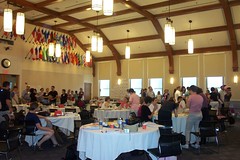From Immersion '06, July 31, 2006
Faculty Lead: Debra Gilchrist
For assessing a program, as opposed to student learning, Deb reframed the 5 questions from her “Assessment-as-Learning” sessions.
- “What do you want the instruction program to be able to do? What does it do when it meets student needs and/or supports student learning?” (Outcome)
- “What factors does the program demonstrate or exhibit if they are meeting the outcomes? What will be happening?" (Indicators)
- “How will you gather your data or evidence?” (Assessment)
- “How will you determine if you have achieved your outcomes?” (Criteria)
- “How will the discussion or evaluation of the data occur? Who will be involved?” (Change)
It is important that the assessment leads into a cycle of continual improvement. Deb’s cycle of Outcomes/Indicators/Assessment/Criteria/Change reminded me of the Plan/Do/Check/Act cycle used in my organization. Deb recommends using ACRL’s “Characteristics of Programs of Information Literacy that Illustrate Best Practices” when establishing program outcomes.
